
Centre of Jaina Studies Newsletter: SOAS - University of London
The eminent Jaina monk Jambūvijayajī passed away on 12 November 2009 after a sudden traffic accident. Born into a Jaina family in Gujarat, India, at the age of 14, he became a Jaina monk under the guidance of Muni Bhuvanavijayajī of the Tapā Gaccha Mūrtipūjaka tradition. Muni Bhuvanavijayajī was his father in secular life and thus, he was not formally educated in academic institutions. However, his genius and his extensive knowledge acquired as the result of intensive studies, both of his own and of other religious traditions, did not remain hidden from the scholarly world. In the preface of Anekāntajayapatākā vol. II, which was published in 1947, H. R. Kapadia refers to Jambūvijaya as "a learned disciple of Bhuvanavijaya... [who] helped me."
During the next decade his reputation as a brilliant scholar of Indian philosophy was established. Pandit D. Malvaniya, then a professor of Jainism at Vārāṇasī Hindu University, recommended Jambūvijaya to the late Professor Astushi Uno, who was a student at VHU. Professor Uno visited Gujarat where Jambūvijaya stayed during the rainy season and commenced a friendship that lasted for more than forty years until 1998 when Professor Uno passed away.
Through Professor Uno some Japanese scholars made his acquaintance and began to correspond with Jambūvijaya. Masaaki Hattori and Yuuichi Kajiyama, for example, respected Jambūvijaya's knowledge not only in the field of Jaina Studies but also in Buddhist philosophy, and in addition his extensive knowledge of Tibetan, mastered with the help of the book Bhoṭaprakāśa, a chrestomathy for Tibetan.
His knowledge covered nearly the whole field of Jaina literature from the āgamas, written in Prakrit, to philosophical Sanskrit treatises. Such literature contains not only the Jainas' own doctrine but also non-Jaina thoughts, i.e., Hindu and Buddhist ideas or opinions. In particular, Jaina treatises or commentaries in Sanskrit such as Dvādaśanayacakra, Dravyālaṃkāra quote many passages from Buddhist literature. Therefore, in order to understand Jaina literature completely we need to have good knowledge of Hindu and Buddhist philosophy. This can be done perfectly only when one commands Sanskrit and Tibetan into which most Indian Buddhist literature was translated, and in which are preserved some works which are no longer extant in the original Sanskrit.
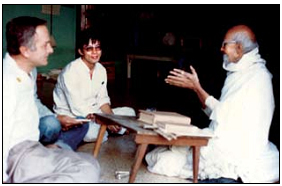
Jambūvijaya c.1982 with Sin Fujinaga and Kendall W. Folkert in north Gujarat. Photo: Ruth Folkert
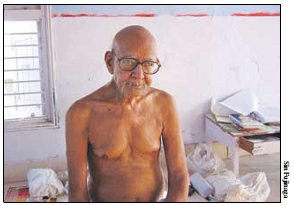
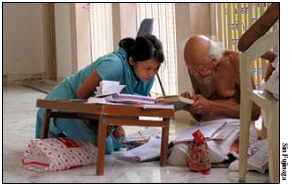
Jambūvijaya is teaching a Buddhist text to a Japanese student (Hiroko Matsuoka) at Jaina upāśraya in Nakoda, Rajasthan, August 2009
Western Indologists also became aware of this young and learned Jain monk. In 1958, E. Frauwallner of Vienna wrote a long and warm-hearted foreword to the first volume of Dvādaśanayacakra of Mallavādin edited by Jambūvijaya. In the course of editing this Jambūvijaya had discovered a recension of the Vaiśeṣikasūtra that was different from those available at that time. So, with the help of a manuscript kept in a Jaisalmer bhaṇḍār, he edited the Vaiśeṣikasūtra with Candrānanda's commentary, which was published in 1961 as No. 136 of Gaekwad's Oriental Series from Baroda.
Jambūvijaya's reputation as a learned Jaina monk spread internationally among scholars of Jaina literature through his editing of the Ācārāṅgasūtra, published in 1977 as No. 2 (I) of the Jaina-Āgama-Series from Mahāvīra Jaina Vidyālaya. Along with other books contained in the series, this edition was of great help to students of the Jaina āgamas. All editions in this series are twentieth century masterpieces of Jaina scholarship. However, they contain only the original texts of the āgamas and the relevant information about them, but no commentaries. Therefore Jambūvijaya started to reedit Jaina āgamas and include commentaries. As the first step, in 1978 he published the first four aṅgas with the vṛtti or ṭīkā which had been formerly published in the Āgamodayasamiti series. After that he decided to critically edit and publish all 45 āgamas with commentaries. The first result is Anuyogadvārasūtram, Part I with three commentaries, published as Jaina-Āgama-Series No. 18 (1) in 1999 from Śrī Mahāvīra Jaina Vidyālaya.
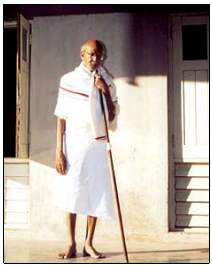
Jambūvijaya at an upāśraya in Palitana, western Gujarat c.1995. Photo: Sin Fujinaga
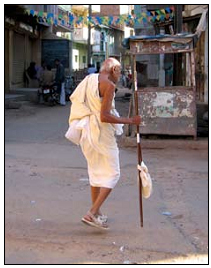
Jambūvijaya in north Gujarat, November 2003. Photo: Sin Fujinaga
Western scholars interested in Jainism as a living religion became aware of Jambūvijaya in 1980. The late Professor Kendall W. Folkert and his student the late Thomas Zwicker, two of the pioneers of the Anthropology of Jainism, met Jambūvijaya in the early 1980s in Gujarat. There they conducted systematic fieldwork on the Jaina laity with his help and advice.
As a Jaina monk, Jambūvijaya followed two basic ways of life: wandering and learning. He continued to wander around for eight months a year and to stay at one place for the remaining four months. When his guru and father was alive, he wandered mainly in Gujarat and States nearby. After his guru died in 1959, he limited the area to Gujarat until 1995 when the nun Manohar, who was the mother of Jambūvijaya in the worldly life, also passed away. During these years he preferred to wander and stay in the rural area of northern Gujarat because there he could concentrate on his studies without any disturbance, and also because such places are located near Sankheshvar, a holy site for most Jainas in Gujarat. For a period of more than three years, Jambūvijaya also started making pilgrimages in north India and visited many holy places. Returning from this long journey on foot, his wandering was again limited to Gujarat and Rajasthan. He preferred to stay at holy sites or places where Jaina bhaṇḍāras are located during the rainy season.
Some advanced Jaina monks or nuns sometimes engage in editing Jaina texts with the help of manuscripts kept in Jaina bhaṇḍāras. In particular, Jaisalmer bhaṇḍāra in Rajasthan is famous for the number and antiquity of manuscripts preserved there. Besides having utilized them in editing the works mentioned previously, Jambūvijaya was very eager to catalogue and preserve them because some manuscripts were written more than 800 years ago on fragile palm leaf. He therefore organized the scanning and photocopying of important manuscripts. Most recently he stayed there for the purpose of completing the digitalisation of the manuscripts.
To our knowledge, Jambūvijaya had few disciples; two of them are Devabhadravijaya and Dharmacandravijaya. The former was initiated in 1958 and died in 1983. The latter has been working to promote Jambūvijaya's work in various ways and is still active as a teacher of monks and nuns.
Jambūvijaya's accomplishments as a Jaina monk and scholar can be divided roughly into three categories: 1) editing Sanskrit or Prakrit literature, 2) compiling the catalogues of manuscripts kept in Jaina bhaṇḍāras and 3) writing independent papers. A complete list of his works will appear in the next issue of the Journal of Jaina Studies (Kyoto 2010).
Sin Fujinaga is a lecturer at Miyakonojō Kōsen (Miyakonojō National College of Technology). His research centres on all aspects of Jainism.
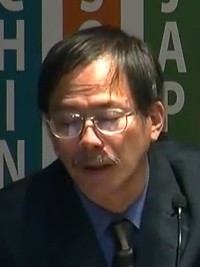 Dr. Shin Fujinaga
Dr. Shin Fujinaga